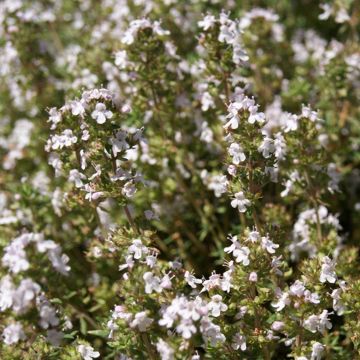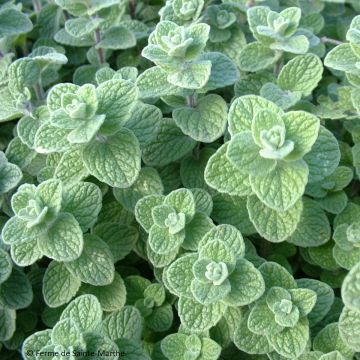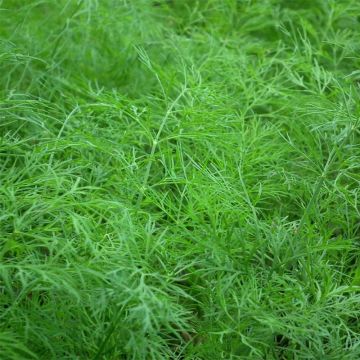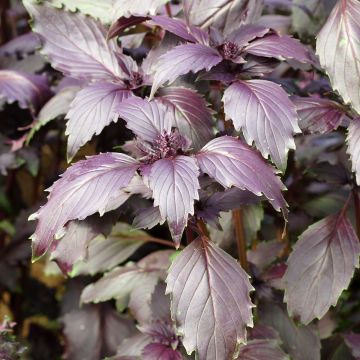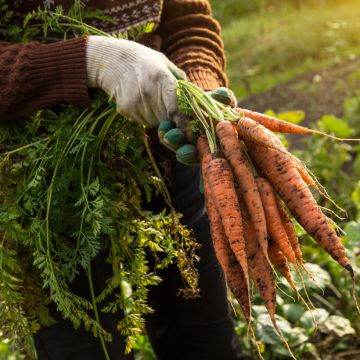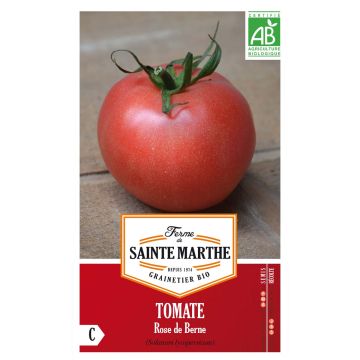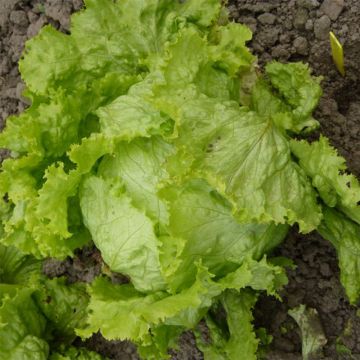

Origan - Marjolaine vivace - Vilmorin
Oregano - Perennial Marjoram - Vilmorin seeds
Origanum vulgare
Wild Marjoram, Common Oregano
Why not try an alternative variety in stock?
View all →This plant carries a 6 months recovery warranty
More information
We guarantee the quality of our plants for a full growing cycle, and will replace at our expense any plant that fails to recover under normal climatic and planting conditions.
Seed-only orders are dispatched by sealed envelope. The delivery charge for seed-only orders is €3.90.
Description
Perennial marjoram (Oregano) is a hardy aromatic plant that is one of the traditional Herbes de Provence. It is a classic ingredient in Mediterranean cuisine, particularly Italian, and is essential for flavouring pizzas. Sow indoors from April to June and harvest as needed from July to September.
Native to Western and Southern Europe, where it grows in the wild, Oregano (Origanum vulgare) is a perennial plant belonging to the Lamiaceae family. It forms a fragrant clump about 50 cm (20in) tall and wide. Its deciduous foliage is composed of round to oval, dark green leaves. Oregano blooms from June to September, with pretty pink to purplish flowers. It is hardy down to approximately -17°C (1.4°F).
Marjoram is a resilient and easy-to-grow herb. It thrives in sunny locations and prefers poor, light, even rocky, and well-drained soils. It is not bothered by limestone. If your soil is rather moist and clayey, we recommend growing it in a pot or on a small mound where it will thrive.
It is worth noting that Oregano is also known as Wild Marjoram or Red Tea, which often leads to confusion with its cousin, Garden Marjoram or Sweet Marjoram (Origanum majorana), which is less hardy and has a different fragrance.
Harvesting: Oregano can be harvested from July to September by cutting the stalks with scissors.
Preservation: Oregano is traditionally preserved by drying. This is a simple and quick process that you can replace with freezing if you find it more convenient.
Gardener's tip: In the garden, don't hesitate to mix different types of plants by planting some aromatic herbs like Oregano in the middle of your perennial flowerbeds, or even in rock gardens. It looks beautiful, and the sometimes strong fragrances of aromatic plants often have the ability to repel insects that may attack more delicate plants, such as certain roses.
Report an error about the product description
Harvest
Plant habit
Foliage
Botanical data
Origanum
vulgare
Lamiaceae
Wild Marjoram, Common Oregano
Cultivar or hybrid
Perennial
Other Herb seeds
Planting and care
Sowing oregano:
Sow in March - April, under cover. Barely cover the seeds with fine soil. Transplant in open ground in mid-May, spacing the plants 30 cm (12in) apart in all directions. To sow directly in place (garden or planter), wait until at least mid-May to avoid any risk of late frost. Thin out after emergence to 10-15 cm (4-6in).
Position in full sun. The soil should be well-drained, light, and rather dry. Add a little sand if your soil tends to be clayey.
Growing oregano:
Mulch with stones to retain heat. In pots, remove stagnant water that can accumulate. Weed regularly and harvest regularly to promote the development of new shoots. As soon as flowering begins, cut the plants by two-thirds to obtain a second harvest.
Oregano has good resistance to diseases. However if the soil is too wet, the roots will rot. Pest insects are few (aphid and red spider mite) and rare.
You can also propagate perennial oregano by dividing the clumps in spring or autumn. It can be pruned at the end of summer.
Seedlings
Care
Intended location
This item has not been reviewed yet - be the first to leave a review about it.
Vegetable seeds
Haven't found what you were looking for?
Hardiness is the lowest winter temperature a plant can endure without suffering serious damage or even dying. However, hardiness is affected by location (a sheltered area, such as a patio), protection (winter cover) and soil type (hardiness is improved by well-drained soil).

Photo Sharing Terms & Conditions
In order to encourage gardeners to interact and share their experiences, Promesse de fleurs offers various media enabling content to be uploaded onto its Site - in particular via the ‘Photo sharing’ module.
The User agrees to refrain from:
- Posting any content that is illegal, prejudicial, insulting, racist, inciteful to hatred, revisionist, contrary to public decency, that infringes on privacy or on the privacy rights of third parties, in particular the publicity rights of persons and goods, intellectual property rights, or the right to privacy.
- Submitting content on behalf of a third party;
- Impersonate the identity of a third party and/or publish any personal information about a third party;
In general, the User undertakes to refrain from any unethical behaviour.
All Content (in particular text, comments, files, images, photos, videos, creative works, etc.), which may be subject to property or intellectual property rights, image or other private rights, shall remain the property of the User, subject to the limited rights granted by the terms of the licence granted by Promesse de fleurs as stated below. Users are at liberty to publish or not to publish such Content on the Site, notably via the ‘Photo Sharing’ facility, and accept that this Content shall be made public and freely accessible, notably on the Internet.
Users further acknowledge, undertake to have ,and guarantee that they hold all necessary rights and permissions to publish such material on the Site, in particular with regard to the legislation in force pertaining to any privacy, property, intellectual property, image, or contractual rights, or rights of any other nature. By publishing such Content on the Site, Users acknowledge accepting full liability as publishers of the Content within the meaning of the law, and grant Promesse de fleurs, free of charge, an inclusive, worldwide licence for the said Content for the entire duration of its publication, including all reproduction, representation, up/downloading, displaying, performing, transmission, and storage rights.
Users also grant permission for their name to be linked to the Content and accept that this link may not always be made available.
By engaging in posting material, Users consent to their Content becoming automatically accessible on the Internet, in particular on other sites and/or blogs and/or web pages of the Promesse de fleurs site, including in particular social pages and the Promesse de fleurs catalogue.
Users may secure the removal of entrusted content free of charge by issuing a simple request via our contact form.
The flowering period indicated on our website applies to countries and regions located in USDA zone 8 (France, the United Kingdom, Ireland, the Netherlands, etc.)
It will vary according to where you live:
- In zones 9 to 10 (Italy, Spain, Greece, etc.), flowering will occur about 2 to 4 weeks earlier.
- In zones 6 to 7 (Germany, Poland, Slovenia, and lower mountainous regions), flowering will be delayed by 2 to 3 weeks.
- In zone 5 (Central Europe, Scandinavia), blooming will be delayed by 3 to 5 weeks.
In temperate climates, pruning of spring-flowering shrubs (forsythia, spireas, etc.) should be done just after flowering.
Pruning of summer-flowering shrubs (Indian Lilac, Perovskia, etc.) can be done in winter or spring.
In cold regions as well as with frost-sensitive plants, avoid pruning too early when severe frosts may still occur.
The planting period indicated on our website applies to countries and regions located in USDA zone 8 (France, United Kingdom, Ireland, Netherlands).
It will vary according to where you live:
- In Mediterranean zones (Marseille, Madrid, Milan, etc.), autumn and winter are the best planting periods.
- In continental zones (Strasbourg, Munich, Vienna, etc.), delay planting by 2 to 3 weeks in spring and bring it forward by 2 to 4 weeks in autumn.
- In mountainous regions (the Alps, Pyrenees, Carpathians, etc.), it is best to plant in late spring (May-June) or late summer (August-September).
The harvesting period indicated on our website applies to countries and regions in USDA zone 8 (France, England, Ireland, the Netherlands).
In colder areas (Scandinavia, Poland, Austria...) fruit and vegetable harvests are likely to be delayed by 3-4 weeks.
In warmer areas (Italy, Spain, Greece, etc.), harvesting will probably take place earlier, depending on weather conditions.
The sowing periods indicated on our website apply to countries and regions within USDA Zone 8 (France, UK, Ireland, Netherlands).
In colder areas (Scandinavia, Poland, Austria...), delay any outdoor sowing by 3-4 weeks, or sow under glass.
In warmer climes (Italy, Spain, Greece, etc.), bring outdoor sowing forward by a few weeks.







































